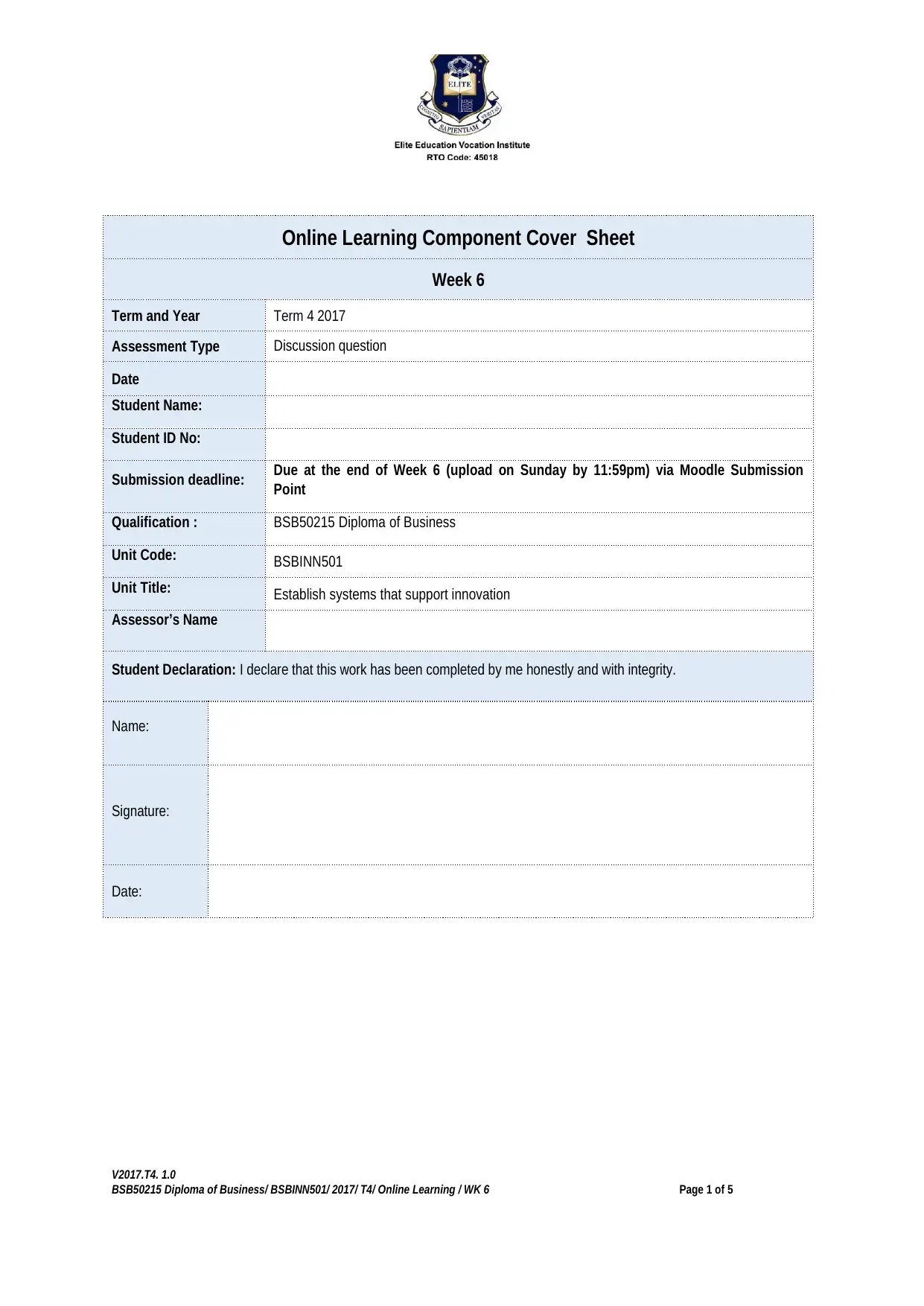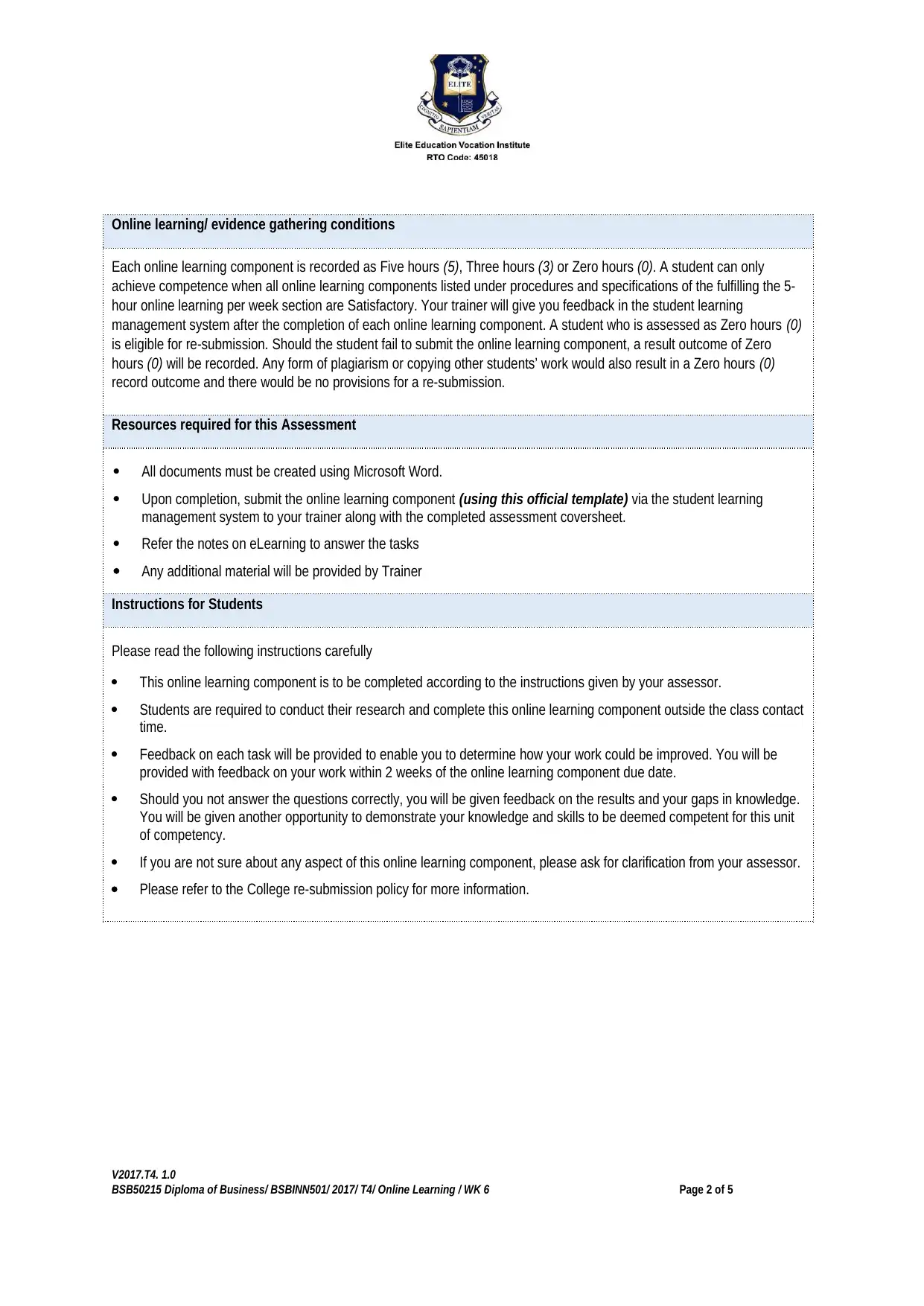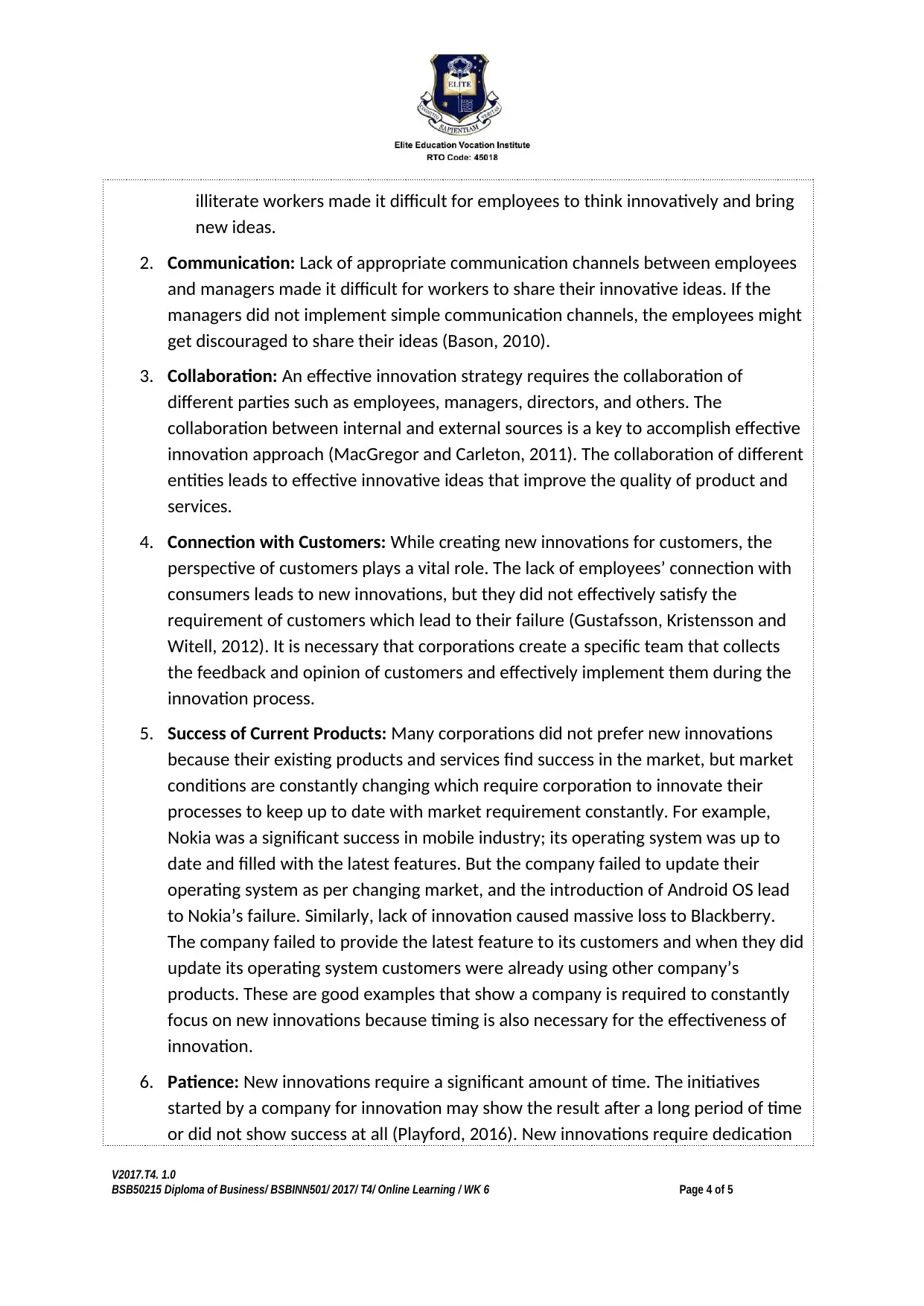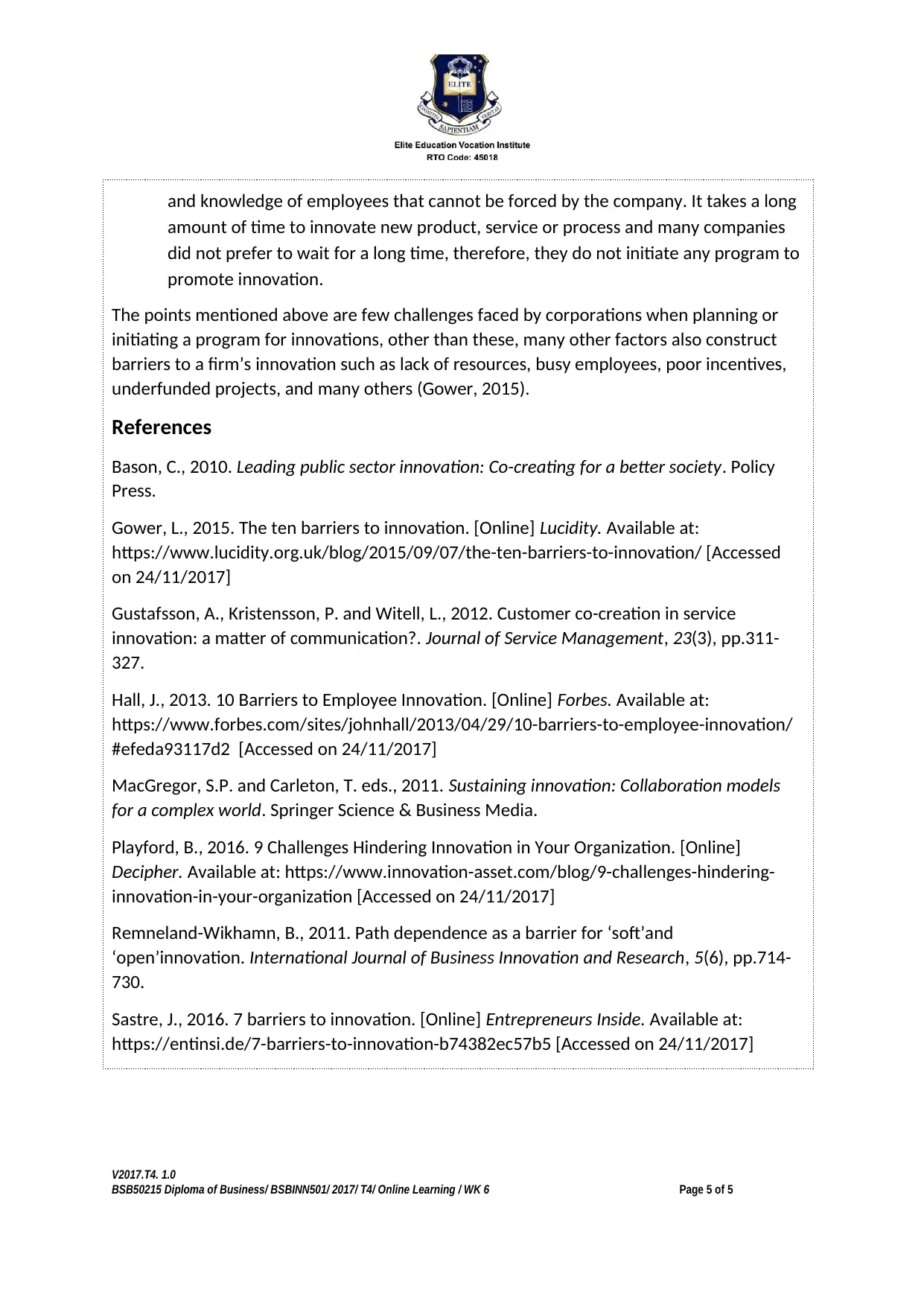BSB50215 Diploma of Business: Innovation Challenges Analysis
VerifiedAdded on 2020/04/13
|5
|1659
|194
Homework Assignment
AI Summary
This assignment, completed for the BSBINN501 unit within the BSB50215 Diploma of Business program, addresses the challenges organizations encounter when planning for innovation. The student's work, submitted as an online learning component, explores various internal and external factors that hinder innovation strategies. Key challenges discussed include employee-related issues such as close-mindedness, traditions, lack of diversity, jealousy, and inadequate education and communication channels. The assignment also highlights the importance of customer connection and collaboration between different parties, the impact of existing product success, the need for patience, and the influence of market changes on innovation. The student provides a comprehensive overview supported by relevant references, demonstrating an understanding of the complexities involved in fostering and implementing successful innovation within a business context.

Online Learning Component Cover Sheet
Week 6
Term and Year Term 4 2017
Assessment Type Discussion question
Date
Student Name:
Student ID No:
Submission deadline: Due at the end of Week 6 (upload on Sunday by 11:59pm) via Moodle Submission
Point
Qualification : BSB50215 Diploma of Business
Unit Code: BSBINN501
Unit Title: Establish systems that support innovation
Assessor’s Name
Student Declaration: I declare that this work has been completed by me honestly and with integrity.
Name:
Signature:
Date:
V2017.T4. 1.0
BSB50215 Diploma of Business/ BSBINN501/ 2017/ T4/ Online Learning / WK 6 Page 1 of 5
Week 6
Term and Year Term 4 2017
Assessment Type Discussion question
Date
Student Name:
Student ID No:
Submission deadline: Due at the end of Week 6 (upload on Sunday by 11:59pm) via Moodle Submission
Point
Qualification : BSB50215 Diploma of Business
Unit Code: BSBINN501
Unit Title: Establish systems that support innovation
Assessor’s Name
Student Declaration: I declare that this work has been completed by me honestly and with integrity.
Name:
Signature:
Date:
V2017.T4. 1.0
BSB50215 Diploma of Business/ BSBINN501/ 2017/ T4/ Online Learning / WK 6 Page 1 of 5
Paraphrase This Document
Need a fresh take? Get an instant paraphrase of this document with our AI Paraphraser

Online learning/ evidence gathering conditions
Each online learning component is recorded as Five hours (5), Three hours (3) or Zero hours (0). A student can only
achieve competence when all online learning components listed under procedures and specifications of the fulfilling the 5-
hour online learning per week section are Satisfactory. Your trainer will give you feedback in the student learning
management system after the completion of each online learning component. A student who is assessed as Zero hours (0)
is eligible for re-submission. Should the student fail to submit the online learning component, a result outcome of Zero
hours (0) will be recorded. Any form of plagiarism or copying other students’ work would also result in a Zero hours (0)
record outcome and there would be no provisions for a re-submission.
Resources required for this Assessment
All documents must be created using Microsoft Word.
Upon completion, submit the online learning component (using this official template) via the student learning
management system to your trainer along with the completed assessment coversheet.
Refer the notes on eLearning to answer the tasks
Any additional material will be provided by Trainer
Instructions for Students
Please read the following instructions carefully
This online learning component is to be completed according to the instructions given by your assessor.
Students are required to conduct their research and complete this online learning component outside the class contact
time.
Feedback on each task will be provided to enable you to determine how your work could be improved. You will be
provided with feedback on your work within 2 weeks of the online learning component due date.
Should you not answer the questions correctly, you will be given feedback on the results and your gaps in knowledge.
You will be given another opportunity to demonstrate your knowledge and skills to be deemed competent for this unit
of competency.
If you are not sure about any aspect of this online learning component, please ask for clarification from your assessor.
Please refer to the College re-submission policy for more information.
V2017.T4. 1.0
BSB50215 Diploma of Business/ BSBINN501/ 2017/ T4/ Online Learning / WK 6 Page 2 of 5
Each online learning component is recorded as Five hours (5), Three hours (3) or Zero hours (0). A student can only
achieve competence when all online learning components listed under procedures and specifications of the fulfilling the 5-
hour online learning per week section are Satisfactory. Your trainer will give you feedback in the student learning
management system after the completion of each online learning component. A student who is assessed as Zero hours (0)
is eligible for re-submission. Should the student fail to submit the online learning component, a result outcome of Zero
hours (0) will be recorded. Any form of plagiarism or copying other students’ work would also result in a Zero hours (0)
record outcome and there would be no provisions for a re-submission.
Resources required for this Assessment
All documents must be created using Microsoft Word.
Upon completion, submit the online learning component (using this official template) via the student learning
management system to your trainer along with the completed assessment coversheet.
Refer the notes on eLearning to answer the tasks
Any additional material will be provided by Trainer
Instructions for Students
Please read the following instructions carefully
This online learning component is to be completed according to the instructions given by your assessor.
Students are required to conduct their research and complete this online learning component outside the class contact
time.
Feedback on each task will be provided to enable you to determine how your work could be improved. You will be
provided with feedback on your work within 2 weeks of the online learning component due date.
Should you not answer the questions correctly, you will be given feedback on the results and your gaps in knowledge.
You will be given another opportunity to demonstrate your knowledge and skills to be deemed competent for this unit
of competency.
If you are not sure about any aspect of this online learning component, please ask for clarification from your assessor.
Please refer to the College re-submission policy for more information.
V2017.T4. 1.0
BSB50215 Diploma of Business/ BSBINN501/ 2017/ T4/ Online Learning / WK 6 Page 2 of 5

Task
Describe the challenges faced by organisation when planning for innovation (not more than 800 words).
Innovation is the process of converting new ideas for products and services into reality to
gain competitive advantage and improve the efficiency of processes. Due to globalisation
and digitalisation, the requirement of business innovation has grown substantially in past
few decades. Modern organisation focus on implementing innovative approaches to gain
competitive advantage and improve the effectiveness of operations (Remneland-Wikhamn,
2011). Innovation in operations benefits all parts of the society including corporations,
customers, government, and communities. Establishing an innovative strategy does not
mean success or advancement of new procedures. Instead, management requires constant
monitoring and supervising the performance to achieve successful results. There are
various internal and external factors of an organisation that negatively affects its
innovation strategy. Following are the barriers or challenges faced by a corporation when
planning for innovation:
1. Employees: The success of an innovation strategy is based on the performance of
employees and their ability to adapt as per the change. The contribution made by
employees assists the company in creating new operations and designing new
products. Several factors adversely influence the innovative ability of the workers
(Hall, 2013). Following are few factors that affect the innovation ability of
employees:
i) Close-Mindedness: The lack of ability to change as per requirement reduces the
innovative approach in an organization. The lack of education and proper
knowledge creates fear in employees' minds, and they react negatively to the
innovative approach (Sastre, 2016). The close-mindedness of a worker also
stops other employees from coming up with innovative ideas.
ii) Traditions: The innovative approach requires change in old traditions, and many
old-fashioned employees did not prefer to change such traditions because they
are emotionally related to them.
iii) Diversity: Lack of diversity influence ability of employees to create new ideas.
For example, lack of female workers made it difficult to bring a female point of
view in new ideas or plans.
iv) Jealousy: The jealousy and office politics reduces innovating thinking of
employees and discourages them from bringing new ideas.
v) Education: Lack of knowledge about business operations, poor qualification and
V2017.T4. 1.0
BSB50215 Diploma of Business/ BSBINN501/ 2017/ T4/ Online Learning / WK 6 Page 3 of 5
Describe the challenges faced by organisation when planning for innovation (not more than 800 words).
Innovation is the process of converting new ideas for products and services into reality to
gain competitive advantage and improve the efficiency of processes. Due to globalisation
and digitalisation, the requirement of business innovation has grown substantially in past
few decades. Modern organisation focus on implementing innovative approaches to gain
competitive advantage and improve the effectiveness of operations (Remneland-Wikhamn,
2011). Innovation in operations benefits all parts of the society including corporations,
customers, government, and communities. Establishing an innovative strategy does not
mean success or advancement of new procedures. Instead, management requires constant
monitoring and supervising the performance to achieve successful results. There are
various internal and external factors of an organisation that negatively affects its
innovation strategy. Following are the barriers or challenges faced by a corporation when
planning for innovation:
1. Employees: The success of an innovation strategy is based on the performance of
employees and their ability to adapt as per the change. The contribution made by
employees assists the company in creating new operations and designing new
products. Several factors adversely influence the innovative ability of the workers
(Hall, 2013). Following are few factors that affect the innovation ability of
employees:
i) Close-Mindedness: The lack of ability to change as per requirement reduces the
innovative approach in an organization. The lack of education and proper
knowledge creates fear in employees' minds, and they react negatively to the
innovative approach (Sastre, 2016). The close-mindedness of a worker also
stops other employees from coming up with innovative ideas.
ii) Traditions: The innovative approach requires change in old traditions, and many
old-fashioned employees did not prefer to change such traditions because they
are emotionally related to them.
iii) Diversity: Lack of diversity influence ability of employees to create new ideas.
For example, lack of female workers made it difficult to bring a female point of
view in new ideas or plans.
iv) Jealousy: The jealousy and office politics reduces innovating thinking of
employees and discourages them from bringing new ideas.
v) Education: Lack of knowledge about business operations, poor qualification and
V2017.T4. 1.0
BSB50215 Diploma of Business/ BSBINN501/ 2017/ T4/ Online Learning / WK 6 Page 3 of 5
⊘ This is a preview!⊘
Do you want full access?
Subscribe today to unlock all pages.

Trusted by 1+ million students worldwide

illiterate workers made it difficult for employees to think innovatively and bring
new ideas.
2. Communication: Lack of appropriate communication channels between employees
and managers made it difficult for workers to share their innovative ideas. If the
managers did not implement simple communication channels, the employees might
get discouraged to share their ideas (Bason, 2010).
3. Collaboration: An effective innovation strategy requires the collaboration of
different parties such as employees, managers, directors, and others. The
collaboration between internal and external sources is a key to accomplish effective
innovation approach (MacGregor and Carleton, 2011). The collaboration of different
entities leads to effective innovative ideas that improve the quality of product and
services.
4. Connection with Customers: While creating new innovations for customers, the
perspective of customers plays a vital role. The lack of employees’ connection with
consumers leads to new innovations, but they did not effectively satisfy the
requirement of customers which lead to their failure (Gustafsson, Kristensson and
Witell, 2012). It is necessary that corporations create a specific team that collects
the feedback and opinion of customers and effectively implement them during the
innovation process.
5. Success of Current Products: Many corporations did not prefer new innovations
because their existing products and services find success in the market, but market
conditions are constantly changing which require corporation to innovate their
processes to keep up to date with market requirement constantly. For example,
Nokia was a significant success in mobile industry; its operating system was up to
date and filled with the latest features. But the company failed to update their
operating system as per changing market, and the introduction of Android OS lead
to Nokia’s failure. Similarly, lack of innovation caused massive loss to Blackberry.
The company failed to provide the latest feature to its customers and when they did
update its operating system customers were already using other company’s
products. These are good examples that show a company is required to constantly
focus on new innovations because timing is also necessary for the effectiveness of
innovation.
6. Patience: New innovations require a significant amount of time. The initiatives
started by a company for innovation may show the result after a long period of time
or did not show success at all (Playford, 2016). New innovations require dedication
V2017.T4. 1.0
BSB50215 Diploma of Business/ BSBINN501/ 2017/ T4/ Online Learning / WK 6 Page 4 of 5
new ideas.
2. Communication: Lack of appropriate communication channels between employees
and managers made it difficult for workers to share their innovative ideas. If the
managers did not implement simple communication channels, the employees might
get discouraged to share their ideas (Bason, 2010).
3. Collaboration: An effective innovation strategy requires the collaboration of
different parties such as employees, managers, directors, and others. The
collaboration between internal and external sources is a key to accomplish effective
innovation approach (MacGregor and Carleton, 2011). The collaboration of different
entities leads to effective innovative ideas that improve the quality of product and
services.
4. Connection with Customers: While creating new innovations for customers, the
perspective of customers plays a vital role. The lack of employees’ connection with
consumers leads to new innovations, but they did not effectively satisfy the
requirement of customers which lead to their failure (Gustafsson, Kristensson and
Witell, 2012). It is necessary that corporations create a specific team that collects
the feedback and opinion of customers and effectively implement them during the
innovation process.
5. Success of Current Products: Many corporations did not prefer new innovations
because their existing products and services find success in the market, but market
conditions are constantly changing which require corporation to innovate their
processes to keep up to date with market requirement constantly. For example,
Nokia was a significant success in mobile industry; its operating system was up to
date and filled with the latest features. But the company failed to update their
operating system as per changing market, and the introduction of Android OS lead
to Nokia’s failure. Similarly, lack of innovation caused massive loss to Blackberry.
The company failed to provide the latest feature to its customers and when they did
update its operating system customers were already using other company’s
products. These are good examples that show a company is required to constantly
focus on new innovations because timing is also necessary for the effectiveness of
innovation.
6. Patience: New innovations require a significant amount of time. The initiatives
started by a company for innovation may show the result after a long period of time
or did not show success at all (Playford, 2016). New innovations require dedication
V2017.T4. 1.0
BSB50215 Diploma of Business/ BSBINN501/ 2017/ T4/ Online Learning / WK 6 Page 4 of 5
Paraphrase This Document
Need a fresh take? Get an instant paraphrase of this document with our AI Paraphraser

and knowledge of employees that cannot be forced by the company. It takes a long
amount of time to innovate new product, service or process and many companies
did not prefer to wait for a long time, therefore, they do not initiate any program to
promote innovation.
The points mentioned above are few challenges faced by corporations when planning or
initiating a program for innovations, other than these, many other factors also construct
barriers to a firm’s innovation such as lack of resources, busy employees, poor incentives,
underfunded projects, and many others (Gower, 2015).
References
Bason, C., 2010. Leading public sector innovation: Co-creating for a better society. Policy
Press.
Gower, L., 2015. The ten barriers to innovation. [Online] Lucidity. Available at:
https://www.lucidity.org.uk/blog/2015/09/07/the-ten-barriers-to-innovation/ [Accessed
on 24/11/2017]
Gustafsson, A., Kristensson, P. and Witell, L., 2012. Customer co-creation in service
innovation: a matter of communication?. Journal of Service Management, 23(3), pp.311-
327.
Hall, J., 2013. 10 Barriers to Employee Innovation. [Online] Forbes. Available at:
https://www.forbes.com/sites/johnhall/2013/04/29/10-barriers-to-employee-innovation/
#efeda93117d2 [Accessed on 24/11/2017]
MacGregor, S.P. and Carleton, T. eds., 2011. Sustaining innovation: Collaboration models
for a complex world. Springer Science & Business Media.
Playford, B., 2016. 9 Challenges Hindering Innovation in Your Organization. [Online]
Decipher. Available at: https://www.innovation-asset.com/blog/9-challenges-hindering-
innovation-in-your-organization [Accessed on 24/11/2017]
Remneland-Wikhamn, B., 2011. Path dependence as a barrier for ‘soft’and
‘open’innovation. International Journal of Business Innovation and Research, 5(6), pp.714-
730.
Sastre, J., 2016. 7 barriers to innovation. [Online] Entrepreneurs Inside. Available at:
https://entinsi.de/7-barriers-to-innovation-b74382ec57b5 [Accessed on 24/11/2017]
V2017.T4. 1.0
BSB50215 Diploma of Business/ BSBINN501/ 2017/ T4/ Online Learning / WK 6 Page 5 of 5
amount of time to innovate new product, service or process and many companies
did not prefer to wait for a long time, therefore, they do not initiate any program to
promote innovation.
The points mentioned above are few challenges faced by corporations when planning or
initiating a program for innovations, other than these, many other factors also construct
barriers to a firm’s innovation such as lack of resources, busy employees, poor incentives,
underfunded projects, and many others (Gower, 2015).
References
Bason, C., 2010. Leading public sector innovation: Co-creating for a better society. Policy
Press.
Gower, L., 2015. The ten barriers to innovation. [Online] Lucidity. Available at:
https://www.lucidity.org.uk/blog/2015/09/07/the-ten-barriers-to-innovation/ [Accessed
on 24/11/2017]
Gustafsson, A., Kristensson, P. and Witell, L., 2012. Customer co-creation in service
innovation: a matter of communication?. Journal of Service Management, 23(3), pp.311-
327.
Hall, J., 2013. 10 Barriers to Employee Innovation. [Online] Forbes. Available at:
https://www.forbes.com/sites/johnhall/2013/04/29/10-barriers-to-employee-innovation/
#efeda93117d2 [Accessed on 24/11/2017]
MacGregor, S.P. and Carleton, T. eds., 2011. Sustaining innovation: Collaboration models
for a complex world. Springer Science & Business Media.
Playford, B., 2016. 9 Challenges Hindering Innovation in Your Organization. [Online]
Decipher. Available at: https://www.innovation-asset.com/blog/9-challenges-hindering-
innovation-in-your-organization [Accessed on 24/11/2017]
Remneland-Wikhamn, B., 2011. Path dependence as a barrier for ‘soft’and
‘open’innovation. International Journal of Business Innovation and Research, 5(6), pp.714-
730.
Sastre, J., 2016. 7 barriers to innovation. [Online] Entrepreneurs Inside. Available at:
https://entinsi.de/7-barriers-to-innovation-b74382ec57b5 [Accessed on 24/11/2017]
V2017.T4. 1.0
BSB50215 Diploma of Business/ BSBINN501/ 2017/ T4/ Online Learning / WK 6 Page 5 of 5
1 out of 5
Related Documents
Your All-in-One AI-Powered Toolkit for Academic Success.
+13062052269
info@desklib.com
Available 24*7 on WhatsApp / Email
![[object Object]](/_next/static/media/star-bottom.7253800d.svg)
Unlock your academic potential
Copyright © 2020–2025 A2Z Services. All Rights Reserved. Developed and managed by ZUCOL.





